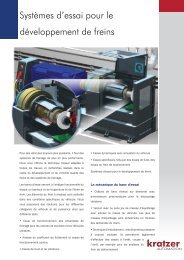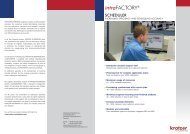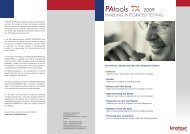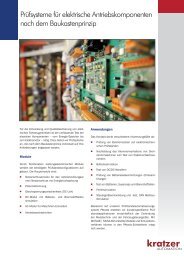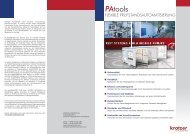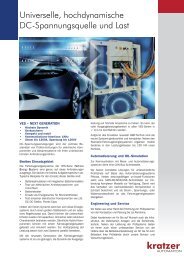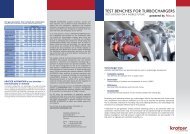intraFACTORY® - Kratzer Automation
intraFACTORY® - Kratzer Automation
intraFACTORY® - Kratzer Automation
Create successful ePaper yourself
Turn your PDF publications into a flip-book with our unique Google optimized e-Paper software.
intraFACTORY ® TraceabiliTy<br />
Even when operating to the highest quality standards it is not always<br />
possible to avoid manufacturing defects entirely. When they<br />
are detected, they have frequently arisen in upstream stages of<br />
the manufacturing process and have already spread “like a virus”<br />
through all downstream production levels and to shipped products.<br />
Uncertainty about the possible extent of a manufacturing<br />
defect explains why so many products are affected in the event<br />
of callbacks.<br />
The solution<br />
When complaints are raised, however, it is possible to pinpoint<br />
the affected products if production keeps full documentation of<br />
components and consumables as well as of every processing<br />
step. In these cases, this data can be used to trace sources of<br />
defects, identify defects clearly and assess their impact.<br />
Traceability is a central function of the intraFACTORY manufacturing<br />
execution system. Its fast stepClient process interfaces ensure<br />
that all production data can be collected without delay even<br />
at extremely high rates.<br />
The prerequisite for complete traceability is the ability to identify<br />
all parts and materials at any time using firmly installed or mobile<br />
scanners (barcode, RFID, microchips).<br />
Tracking and tracing on batch level<br />
To narrow down tracing effort, components and materials that<br />
cannot be identified directly (for instance firms, bulk material)<br />
have to be separated in their batches. intraFACTORY extends the<br />
master data for components into self-interpreting trace numbers<br />
with details of the batch, expiration date, inspection results and<br />
quantity in the batch (see the example at the bottom right).<br />
It is essential to trace material on batch level because manufacturers‘<br />
codings may be mixed in the batches. And with post-setup<br />
activities, too, batches may mix, giving rise to uncertainties that<br />
the intraFACTORY Material Manager allows for by transitionally<br />
posting both the old and the new batch.<br />
Greater process reliability<br />
In addition to pinpointing the impact of manufacturing defects,<br />
the traceability facility provides you with maximum transparency<br />
about corporate processes, the potential to improve them and<br />
the ability to increase process reliability by reducing the risk of<br />
manufacturing defects.<br />
Expansion to full-scale MES functionality<br />
intraFACTORY Traceability is a module of the intraFACTORY Shop<br />
Floor Edition. By using other standard modules – such as Material<br />
manager, Process locking (Advanced Process Control APC),<br />
Order tracking with online reporting amd Repair Manager – you<br />
can establish a custom manufacturing execution system (MES,)<br />
step by step, that extends as far as goods-in and shipping.<br />
DEFECT<br />
bacKWarD TracKiNG FOrWarD TracKiNG<br />
Find defect<br />
causing process<br />
Remove<br />
defect<br />
Block effected<br />
batches<br />
Find source<br />
of defect<br />
Block affected<br />
components<br />
Inform affected<br />
customers<br />
Targeted<br />
remedy<br />
The „W“ questions of tracking and tracing<br />
Forward tracking entails finding the potential impact of defects<br />
on products that have already been completed, whereas<br />
backward tracking makes a distinction between product and<br />
process traceability.<br />
Product traceability<br />
What component has been fitted<br />
into which product<br />
under which batch number and when,<br />
as part of which order lot,<br />
using what material,<br />
and for which customer ?<br />
Process traceability<br />
How was the product made,<br />
on which line<br />
and in which production step,<br />
under what conditions,<br />
using what resources,<br />
by which employees<br />
and what were the results ?



